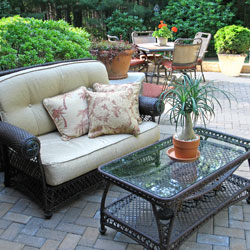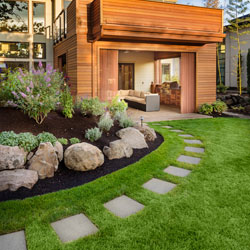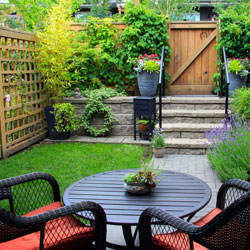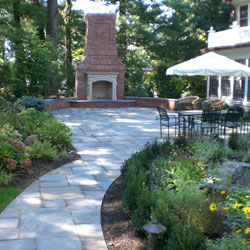An outdoor living area offers many possibilities for enjoyment, entertainment and relaxation, but is your space big enough for everything you want to do? You don’t necessarily need a large area to meet your needs, but it is crucial that you size your outdoor space appropriately and comfortably.
How Much Space Do You Really Have?
The size of your outdoor space isn’t as simple as your property size, and you need to carefully assess exactly how much space you have to work with when planning an outdoor living area. For example, some portion of the lawn and landscaping is always unable to be turned into more practical spaces, as many homeowner or community associations, as well as municipality regulations, require some percentage of a property’s space to remain green. Flowerbeds, sheds, borders, side yards, driveways, pathways and the footprint of the house also usurp space and change the flow of your yard, impacting how you size an outdoor space. The overall shape of the yard will also help determine how much available space you have to work with. By carefully appraising the available space – taking into account mature sizes of landscaping and how larger plants may overgrow an area – you will be able to more efficiently size your outdoor space to create a living area you’ll love.
Sizing Your Outdoor Space
There are many different sizing factors you need to consider when planning an outdoor living area. By carefully considering these different needs, you will be able to choose a size appropriate to your budget, needs and preferences.
- Proportion: One of the most important factors in sizing an outdoor space is its proportion to the overall property and landscape. A huge patio, deck or other outdoor space can overwhelm a small yard and house, while a tiny patio can look awkward next to a huge, elaborate structure.
- Activity Level: The more you plan to move around your outdoor space, the larger it will need to be to accommodate that movement safely and comfortably. Consider active children, energetic pets, and any activities you may want to do, such as frequent entertaining.
- Furniture: Your space needs to be large enough to accommodate outdoor furniture, including seating, tables or storage benches, plus room to move around that furniture without stumbling. Also consider whether furniture will be used only on special occasions or more frequently.
- Seating Type: The seating you choose for your space will affect the necessary size of the area. A hammock, for example, needs room to swing and sway, while folding chairs are more compact. Recliners or deep seating need extra space, while benches are great options for smaller spaces.
- Table Size: If a table will be part of your outdoor space, be sure there is enough room for seating around the table as well as for guests to move to their seats. A large outdoor dining table requires more space than a café set, while end tables can create blocks or fill in tight corners.
- Fire Pits: A fire pit can be a great centerpiece for your outdoor space, but it needs room for the flames as well as a safety buffer so there is no risk of unwanted fires. A larger pit will require a broader space so guests don’t feel too much heat when they gather around.
- Play Areas: If you plan to incorporate a play area such as a jungle gym, playhouse, sandbox, basketball hoop, putting green or other active area into your space, you need to have room not only to use the area, but to move around it when others are using it as well.
- Gardening Zone: A garden can be a great use of yard space and a fun addition to your outdoor living area, but be sure to account for space between garden rows as well as storage for tools. Container gardens or raised beds are the most compact options for small spaces.
- Room for Plants: Even if you aren’t a gardener, you will likely want some plants as part of your outdoor space, from window boxes to specimen plants. Plan for their mature size, as well as proper spacing for air circulation and to keep the plants disease- and pest-free.
- Storage: Consider how much storage space you need outside for garden tools, children’s toys, sports equipment, patio cushions, a grill and other accessories. Storage benches, dock boxes, sheds or storage carts are great options that can fit into many different spaces.
- Traffic Flow: How you get around your outdoor living area has to be factored into sizing considerations. Note pathways, stairs and how doors or gates open into the area, and also take into account how people will move in relation to nearby windows or other doorways.
- Null Space: Every well-designed outdoor space will have some null areas, space taken up by planters, a fountain, steps, pillars or other features. This limits the functional space in the area, and should be carefully considered so the space isn’t too small.
- Versatility: If your outdoor dreams include many different activities, a larger, more versatile space may be necessary so you can shift around furniture or planters to accommodate different uses. Screen walls can help create a more functional space that can easily be arranged.
- Cost: Your budget should definitely be factored in to your outdoor space sizing, but price doesn’t need to define the space. Larger spaces can be built incrementally as the budget permits, and qualified experts can suggest alternatives to work with the budget you have without compromising quality,
Need some help determining the best size for all your outdoor ambitions? Let our experts help you assess your space and plan the perfect size for all the outdoor living you want to do!

















